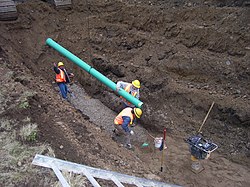Sanitary sewer
Modern sewer systems often separate rainwater from polluted water. "Wastewater" (polluted water, also called sewage) is treated before it is released into a river or lake again. This treatment may not be needed for rainwater (also called stormwater). This idea of using separate sewer systems for wastewater and rainwater is called sanitary sewer.
A sanitary sewer or foul sewer is an underground pipe or tunnel system for transporting sewage from houses and commercial buildings to treatment facilities. Sewage is treated to control water pollution before discharge to surface waters.[1]
Cholera is a deadly disease caused by foul water. The system of treating foul water was first invented in London. There cholera had repeatedly caused disease,[2] but in the middle of the 19th century the first successful water treatment plants were invented.[3]
Sanitary Sewer Media
Sanitary sewer installation with PVC pipe. Sanitary sewers are sized to carry the amount of sewage generated by the collection area. These sewers are much smaller than combined sewers, which are designed to also carry surface runoff.
Schematic of a conventional sanitary sewer to convey blackwater and greywater from households to a centralized sewage treatment facility.
A manhole cover for a sanitary sewer access point.
View looking down into an open manhole showing two converging sanitary sewer lines. The larger line enters from the right and changes direction within the manhole to exit from the top of the photo. A smaller line enters from the bottom of the photo under the access steps. The concrete floor of the manhole has channels to minimize accumulation of solids.
Stoneware sanitary sewer (bottom) submerged in trash and fecalia
Old brick sanitary sewer from second half of the 19th century. Prague, New Town
Related pages
- Sir Joseph Bazalgette
- Dr. John Snow
References
- ↑ A.V. Koodie and I.J. Kirkaldy 2999. Uprating of Mogden Sewage Treatment Works, in Design, Operation and Economics of Large Wastewater Treatment Plants: Selected Proceedings of the 8th IAWQ International Conference on Design, Operation and Economics of Large Wastewater Treatment Plants, Held in Budapest, Hungary, 6–9 September 1999, Water Science and Technology 41.9, 2000, pp. 53–62.
- ↑ Halliday, Stephen 2013. The Great Stink of London: Sir Joseph Bazalgette and the cleansing of the Victorian metropolis. Stroud: History Press. ISBN 978-0-7509-2580-8
- ↑ Philip Howard 1975. London's River. London: Hamilton, p223. ISBN 9780241892374,







